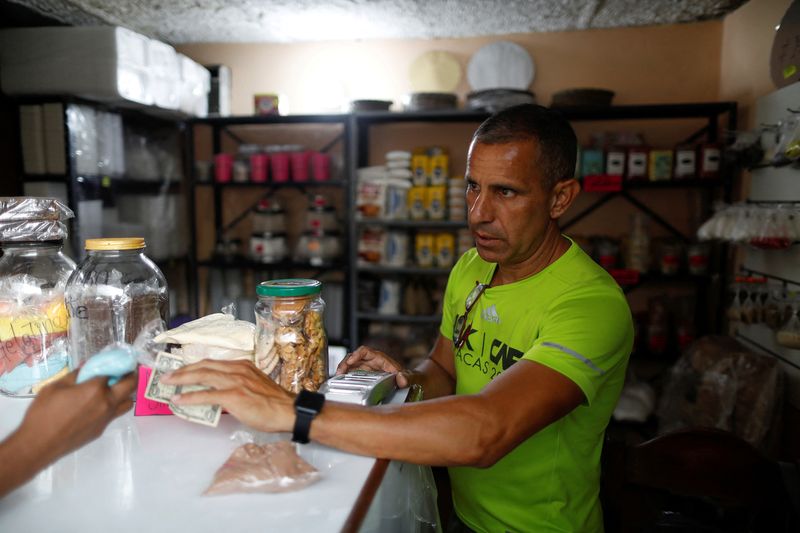Forex
‘The boom is over’: Venezuelans lament end of brief dollarization boost


© Reuters. FILE PHOTO: A worker receives a dollar cash payment in a store in a market in Caracas, Venezuela, August 12, 2021. REUTERS/Leonardo Fernandez Viloria/File Photo
2/3
By Mayela Armas
CARACAS (Reuters) – When Venezuela’s economy was showing tentative signs of recovery in 2020, Enrique Perrella thought it was time to open a cafe in eastern Caracas serving coffee, desserts and breakfasts.
But by January of this year, faced with rising rent, increased taxes and financing constraints, he closed it down.
“The boom is over,” said Perrella. “There is no protection for investment.”
After a brief recovery on the back of de-facto dollarization, Venezuela’s economy is once again falling victim to high inflation, lagging salaries, and decreases in purchases and production of goods, say business owners and analysts.
The government of Nicolas Maduro relaxed currency controls in 2019, allowing more transactions in dollars despite U.S. sanctions. The move led to a slight recovery in 2021 and 2022 after eight years of economic collapse and the migration of some 7.3 million Venezuelans.
Maduro hailed economic growth of 15% last year and said in August that expansion was continuing.
But merchants and analysts said the dollarization boost has proven insufficient in the face of limited credit, a depreciating local currency, higher taxes, straitened public spending amid lower oil income, and rising utility bills.
Economic activity decreased 7% in the first half of 2023 compared to the same period the year before, according to the non-governmental Venezuelan Finance Observatory, while inflation reached 398% year-on-year in July, according to the central bank.
Last month, Yaner Fung shuttered the small supermarket he had owned in western Barquisimeto for 15 years.
“I had to close because in the last two months sales were falling due to less purchasing power … and more than anything because of increases in taxes and utilities,” he said.
Fung now works for a similar business.
“I went from owner to employee.”
‘NO BUYING CAPACITY’
Other businesses which have survived said they were slashing prices, salaries and profit margins to stay afloat.
“To keep up operations we had to cut salaries and work fewer days a week,” said the owner of a small food factory in the industrial central city of Valencia who asked not to be identified. “There is no buying capacity.”
Industrial production was down 7.6% in the first half of the year, compared with the same period in 2022, according to manufacturing guild Conindustria. Commercial sales were down 9% in the same period, local analyst firm Ecoanalitica said.
The central bank, which has not released gross domestic product figures since 2019, did not respond to requests for comment.
“In the first half of 2022 we saw growth facilitated by a decrease in controls and greater use of the dollar, but then that decelerated,” said Jesus Palacios of Ecoanalitica. “Structural economic problems like scarce credit, an absence of recovery in public utilities, among others, were not resolved.”
Retailers in capital Caracas are offering discounts to drum up custom, but merchants said many people still cannot afford to shop because of low salaries.
“Years ago I felt like a millionaire, today my salary isn’t enough,” said Migdalia Uviedo, 58, a retired teacher who now works as a tutor and seamstress. “To survive I look for cheaper food.”
Uviedo’s pension is equivalent to $9 a month. With her other work, she makes a total of about $20.
A dozen eggs costs about $4, while a kilo of chicken goes for $3 and a liter of milk $1.80.
Over half of Venezuelans earn less than $100 a month, says Ecoanalitica, and even those families who receive some income in dollars can struggle to afford food and medicine.
Restaurants, cafes and bakeries like Perrella’s blossomed with dollarization. But 25 have closed in Caracas already this year, said Ivan Puerta, head of the Chamber of Restaurants.
Those remaining have been discounting heavily to lure customers, with lunches which cost $20 at the start of 2023 now going for $10. But sales are down, restaurateurs said, while input costs have quadrupled in the last year.
“We have to keep reinventing,” said Giulio Gallucci, a partner in a Mexican restaurant.

 Forex3 years ago
Forex3 years agoForex Today: the dollar is gaining strength amid gloomy sentiment at the start of the Fed’s week

 Forex3 years ago
Forex3 years agoUnbiased review of Pocket Option broker

 Forex3 years ago
Forex3 years agoDollar to pound sterling exchange rate today: Pound plummeted to its lowest since 1985

 Forex3 years ago
Forex3 years agoHow is the Australian dollar doing today?

 Cryptocurrency3 years ago
Cryptocurrency3 years agoWhat happened in the crypto market – current events today

 World3 years ago
World3 years agoWhy are modern video games an art form?

 Commodities3 years ago
Commodities3 years agoCopper continues to fall in price on expectations of lower demand in China

 Economy3 years ago
Economy3 years agoCrude oil tankers double in price due to EU anti-Russian sanctions



























